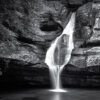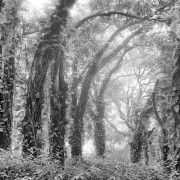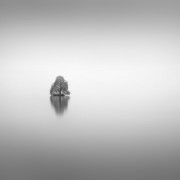Altering the Mood with Black and White Flower Photography
One of my lockdown resolutions is to experiment with various post-processing techniques. I am always looking for ways to spark my creativity. I love colorful flowers and my cultural background affords me to appreciate colors and their unusual combinations. But lately I am realizing that pretty colors alone do not make a photograph interesting. Shape, texture, tones, and lines are integral parts of any composition. Limiting the color range of my flower photography helps me focus on these other elements. I took up a black and white photography project and I am discovering new post-processing techniques. I’m learning to apply black and white elements in exciting ways.
Let’s compare before and after examples where I’ve converted color flower photography to black and white. You will see how post-processing techniques affect mood and improve impact.
Getting Started with Black and White Flower Photography
To get the best technical results, you need a lightbox, your favorite camera, a macro lens, and basic Photoshop skills. Additional software includes NIK Silver Effex and NIK Colorr Efex. I use a homemade lightbox, however, there are professional models available online. A small area can serve as a makeshift studio for flowers as they do not ask much space.
You might feel a completely different mood in these photographs than me. That is fine because mood is subjective! We each bring our own memories, culture, and ideas to our photographs. If you find yourself disagreeing with me, ask yourself more questions like:
- How would I describe this photograph’s mood?
- If this is not cheerful to me, then what would be?
- When I think of eerie images, what comes to mind?
As you read the case studies below, remember how a flower photo makes me feel may not be the same as how it makes you feel.
Black and White Dahlia Photography
The following dahlia was shot outside in the garden. I backlit the flower with the sun, as I would with a light box. This casts a cheery glow through the pale yellow and white petals, highlighting the monochromatic tones in the dahlia. The yellow draws your eye to the darker nooks at the base of each petal. And, if you’re like me, your eye will start tracing circles around each petal, especially those in the foreground. These circles stand out against the petals in the back, which fade into the white background.
Your eye then naturally draws towards the crispest and highest contrast part of the photograph, the center of the bud. Although it is striking, many of the dahlia’s fine details are lost. It is both a mysterious and cheerful image.
Let’s see if we can find a different mood with black and white techniques. I really wanted to create a high contrast moody effect for this photo. So I started to play with Adobe Photoshop and NIK Silver Efex. Photoshop for black and white editing, inverting the colors, and NIK Color Efex to solarize. Solarization photography involves exposing film to white light for a few seconds during darkroom processing. The sensitive printing solution reacts, creating a silvery image. Today’s powerful editing software can emulate these same techniques, so digital photographers don’t have to miss out on all the darkroom fun.
The result on the dahlia is striking. The bright white background transforms into a dark vignette from which the flower emerges. This version glows as well but the source is the dahlia itself instead of the backlight. The loops of the foreground petals stand out and we can see much clearer that the pattern encircles the entire flower. As they fade into the black background, they are almost ghostly. The center of the bud still draws your eye, this time to the petals’ textures and strong lines. The petals contrast starkly with the pin prick center of the flower, previously unremarkable.
Photography Carnation Flower
I shot this carnation on a light box. The yellows, peaches, and pinks shine through in this composition. The center looks gray, however, which I don’t love. The flower’s transparent petals fade into the background. I can’t be the only one who sees fireworks here!
Next, I applied the solarization technique to this flower using Photoshop (image below). The wide tonal range of the flower shines now in black and white with light and shadow inverted. The formerly dull gray center of the carnation is now its brightest spot. The focus is on the textures and folds of the petals rather than the colors. The natural transparency of the petals stands out against a black background, especially in the places where the petals fold or overlap. The petals look soft and touchable. Your eye follows new lines spiraling around the composition due to the inverted light on the edges of the petals.
Instead of fireworks, this version reminds me of old marble statues carved to look like draped cloth. Amazing what a difference these adjustments made! What does it remind you of?
The mood had changed drastically from the colorful version. How could I push this further and really get creative? I took this image into Silver Effex and experimented with various presets to create a bit more dynamic image yet a little under-exposed. This enhances the shapes of individual petals and the darker sections emerge eerily from the black behind them. Photography is the same and the impact is clear between v1 and v2.
Flower Photography with a Chrysanthemum
This mum was torn into pieces and I rearranged it on the lightbox. Yes, even an imperfect subject can become artful photograph. The pale white petals, yellows, and greens are faint here. Just like the carnation, this flower fades into the lightbox background.
After inverting colors in Photoshop and using NIK solarization technique, here is what I got. Have you seen a fire dancer perform and watched the lights swing through the air? The petals of this flower remind me of those performances. There’s so much movement in this still, pale, torn up mum. I would print this one on metal, glass or acrylic to make a stunning wall hanger. The silver tones would play beautifully with a high-gloss medium.
Creating Fine Art with a Morning Glory
These are roadside morning glories. I carry clippers in my car for occasions like this. You never know when you might have to pull over for a great shot!
A simple arrangement on the lightbox got me to this image. I followed the principle of Ikebana. Less is more in this Japanese flower arrangement style. You’ll see across my flower portfolio that I don’t like clutter; nature can often stand on its own.
Once again, I inverted the colors of this morning glory and applied NIK solarization. Ikebana turned into an Art Nouveau! This European style used curving lines, floral motifs, and asymmetry to create beautiful designs. Think Tiffany Glass Co. or Alphonse Mucha’s advertisements. If I had made this composition more complex, the delicate details of this version would be lost.
The trumpet-shaped flowers are the main focus here. The light and shadow, created by the backlight of the lightbox, pop against a black background. The small buds help transition between the bright white flowers and the less prominent vines.
The vine is now a silhouette, almost slithering through the frame. This highlights the curves of the vines and angles of the leaves. The viewer’s mind is allowed to fill in the lines as they imagine, or just let them fade into the background. These elements are interesting on their own but do not distract from the main subject, the flowers.
Now that I was really in the editing zone, I couldn’t stop with just one experiment. I pulled up a different picture from this shoot to play with. The last picture was all about the black tones… what if I focused on whites this time?
I liked the green sepals at the base of the flowers, which have a blank, black tone in v1. So I isolated and enhanced the green hues of the flowers and leaves. Paired with brighter white tones, the green sepals complete the form of the flowers. The leaves and buds remain sharp shapes and still provide a transition between flower and vine.
I also increased the visibility of the vine, which winds across the photograph like a road map. The effect of a bright white and green vine versus a black silhouette is clear, I think.
I let the back sides of the flowers fade into the black background, letting the high-contrast backlighting work in my favor. It emphasizes the trumpet-like shapes and creates strong lines in the flowers, which complement the vine and leaf shapes.
Conclusion
Do you know what works for me to get into a creative mode? Not deadlines and not any agenda. But rather music and tea after a long day while I cook up all these techniques trying to set myself apart from the crowds. If you want to learn the steps for post-processing flower photography, check out my online classes on Visual Wilderness.
I have a lot more to share in the coming months so stay tuned.



















